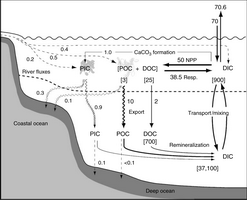
U.S. Dept. of Commerce / NOAA / OAR / PMEL / Publications
As there were no ocean carbon measurements during the pre-industrial period (prior to c.1800), we have to use indirect geochemical evidence and our understanding of current carbon cycle dynamics to infer how the ocean carbon cycle operated prior to human intervention. One aspect of the global carbon cycle that helps us to better understand the pre-industrial period is the fact that atmospheric CO2 concentration was remarkably stable, with variations in atmospheric CO2 of <20 ppm, during at least the last 11,000 years prior to the anthropogenic perturbation (Joos and Prentice, 2004). Since global ocean circulation operates on timescales of ~1000 years and sea–air exchange has time-scales of about 1 year (Broecker and Peng, 1982), the ocean must have been in a steady state with respect to the atmosphere and terrestrial biosphere (the only other sizable carbon reservoirs with comparable exchange timescales) during this period.
Figure 3.1 shows a recently compiled budget of the pre-industrial ocean carbon cycle (Sabine et al., 2004a). It shows some of the complexity of the carbon transformations within the ocean. The gross exchanges across the sea–air interface are estimated to be ~70 Pg C/year. These fluxes are about ten times larger than the current emissions of CO2 into the atmosphere from burning fossil fuels, but since the CO2 release is very nearly balanced by an oceanic uptake there is little net effect on atmospheric CO2 concentrations. The pre-industrial ocean is estimated to have a small net flux (~0.6 Pg C/year) out of the ocean to balance the carbon that enters from rivers and groundwater (Ridgwell and Edwards, Chapter 6, this volume). The river input comes from the terrestrial biosphere and the weathering of continental rocks, which in turn absorb the CO2 from the atmosphere (Watson and Orr, 2003).
Fig. 3.1. Schematic representation of the pre-industrial ocean carbon cycle. Fluxes (arrows) are in Pg C/year and reservoir sizes (numbers in square brackets) are in Pg C. (Modified from Sabine et al., 2004a.) Abbreviations: PIC, particulate inorganic carbon; DOC, dissolved organic carbon; DIC, dissolved inorganic carbon.
The partial pressure of CO2 (pCO2) in pre-industrial surface sea water is estimated to have roughly the same geographical and seasonal variability as the modern ocean, with values ranging from 150 to 750 ppm. Model studies suggest that prior to 1800 the northern hemisphere oceans were taking up atmospheric CO2 while the Southern Ocean was a net source of CO2 to the atmosphere. Recent transport calculations as part of the second Ocean Carbon Model Intercomparison Project (OCMIP-2), which included 12 ocean carbon general circulation models (GCMs), indicated that in pre-industrial times carbon was transported southward in the ocean interior across the equator at an average rate of just under 0.35 Pg C/year (Orr, 2004). This net transport was most likely lost back to the atmosphere in the Southern Ocean as a net atmospheric transport of carbon northward across the equator is required to balance the northern oceanic uptake. This is in contrast to the current scenario in which rising atmospheric CO2 concentrations have made the modern Southern Ocean a net sink for CO2 and the predominantly northern hemisphere sources of fossil fuel burning have resulted in a net atmospheric carbon transport from north to south, the same direction as the net ocean transport.
Return to previous section or go to next section